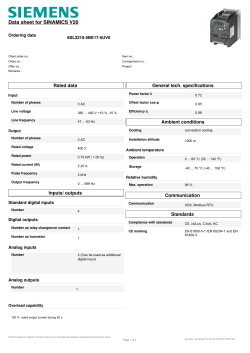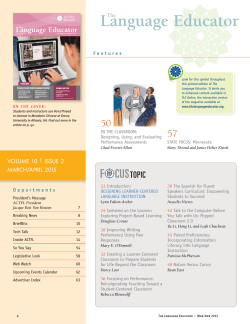
Introduction to Operations What is OM Management 35A00210
35A00210 Operations Management Lecture 1 Introduction to OM Lecture 1 Introduction to Operations Management What is OM What is OM Transformation processes Manufacturing vs services Operations strategy Operations management at IKEA Supermarket Plastic container manufacturer Milk product packaging Design elegant products which can be flat-packed efficiently Milk product processing Chemical manufacturer Cardboard container manufacturer Transport company Dairy farmer Site stores of an appropriate size in the most effective locations Ensure that the jobs of all staff encourage their contribution to business success Continually examine and improve operations practice Oil refinery Paper mill Maintain cleanliness and safety of storage area Lumber company OM 2013 - L1 Design a store layout which gives smooth and effective flow OM 2013 - L1 Arrange for fast replenishment of products Monitor and enhance quality of service to customers 5 What is OM about? Who said operations are boring? The ultimate goal: fulfilling people’s needs Needs are filled by producing products and services Operations is responsible for production OM 2013 - L1 6 Various definitions of what OM is? OM 2013 - L1 8 One pretty universal OM-definition a) Transforming inputs to outputs Designing company’s processes, managing it’s resources and developing capabilities, which help to transform raw materials to products and services customers value b) Designing, managing and improving the production system that develops company’s products and services c) Managing company’s business processes d) Planning, designing, operating, controlling and improving OM 2013 - L1 OM has strong ”managerial” and ”getting things done” focus 9 OM 2013 - L1 10 Even traditionally defined OM is a wide area Why study OM-issues? Value added very likely operations based - has be to understood no matter where one works - e.g. accounting, finance, marketing, information technology… - numerous career opportunities / have to? Significant role in company’s every day life - most of the costs are operations based Success is achieved by doing things right - many problems can be led to OM-mistakes - “Bad execution kills CEO’s” (Fortune-magazine) - ”Brilliant strategy, but can you execute?” (McKinsey & Co.) - operational excellence as a strategy - importance understood again in recent years OM 2013 - L1 12 Who should be interested in operations? OM 2013 - L1 Operations are the heart of corporations - case Disney World - Inputs constantly transformed to outputs e.g. accounting manager Forecasting demand and managing capacity Equipment acquisition, locating and maintenance Quality assurance Procurement of stores Workforce training and scheduling Management of queues and cleanliness Use of technology Cost cutting etc.. - input: data, information, employees - transformation: processes, knowledge, following the rules - output: reports, knowledge of success You cannot hide from people, material and machines - grocery store visit is a simple inventory problem - painting a house requires job design - etc. OM is a useful way of thinking - not only a profession OM 2013 - L1 14 15 OM 2013 - L1 16 How do operations differ from each other? Operations differ by the Four “V”s Production volume - impacts almost everything Low Volume (of production) High High Variety (of production) Low High Variation (in demand) Low High Visibility (customer contact) Low Complexity of product variety - smaller variety eases operations Fluctuation in demand - level demand much easy to manage Relation between product and service - influences the requirements for operations Role of the customer - influences directly the process design OM 2013 - L1 17 Lecture 1 Introduction to OM The Four “V”s - Implications IMPLICATIONS IMPLICATIONS Low repetition Staff members perform more of job Less systemisation High unit costs Low Volume High High repeatability Specialisation Systemisation Capital intensive Low unit costs Flexible Complex Match customer needs High unit cost High Variety Low Well defined Routine Standardised Low unit costs Changing capacity Anticipation Flexibility In touch with demand High unit cost High Variation in demand Low Stable Routine/Predictable High utilisation Low unit cost Short waiting tolerance Satisfaction governed by perception Customer contact skills High unit cost High Visibility (contact) Low Lag between production and consumption High staff utilisation Low unit cost Transformation processes 19 OM 2013 - L1 OM 2013 - L1 18 What are operations about? Different transformations Production is only one type of transformation process Process Management - physical - manufacturing, chemical - locational - transportation - exchange - sales - informative - telecommunication - storage - inventory - physiological - health - mental - education - attitudinal - entertainment Transformation process Inputs Activities and inventories Material Customers Outputs Products Services Workforce and money Resources OM 2013 - L1 Lecture 1 Introduction to OM 21 OM 2013 - L1 22 Service Definitions “Services are deeds, processes, and performances.” Zeithaml & Bitner Manufacturing vs services “A service is a time-perishable, intangible experience performed for a customer acting in the role of a coproducer.” James Fitzsimmons “Service enterprises are organizations that facilitate the production and distribution of goods, support other firms in meeting their goals, and add value to our personal lives.” James Fitzsimmons OM 2013 - L1 24 Percent Employment in Services Output from most operations are a mixture of goods and services - Top Ten Postindustrial Nations Country 1965 1975 1985 1995 2005 United States 59.5 66.4 70.0 74.1 78.6 United Kingdom 51.3 58.3 64.1 71.4 77.0 The Netherlands 52.5 60.9 68.3 73.4 76.5 Sweden 46.5 57.7 66.1 71.5 76.3 PURE GOODS Tangible Crude oil production Can be stored Aluminun smelting Production precedes consumption Special machine manuf. Low customer contact Can be transported Quality is evident Tailoring Canada 57.8 65.8 70.6 74.8 76.0 Australia 54.6 61.5 68.4 73.1 75.8 France 43.9 51.9 61.4 70.0 74.8 Japan 44.8 52.0 57.0 61.4 68.6 Management consultancy Germany 41.8 n/a 51.6 60.8 68.5 Psychotherapy clinic Italy 36.5 44.0 55.3 62.2 65.5 Restaurant Intangible Computer systems service Insurance Cannot be stored Production and consumption are simultaneous High customer contact Cannot be transported Quality difficult to judge PURE SERVICES 27 OM 2013 - L1 25 Typical characteristics of services Service Process Intangibility - measuring quality and efficiency hard and very subjective - opportunity to mass customize quite easy Inseparability - rather labor oriented and customer part of the process Heterogeneity - both input and output differs (customers have an impact) Perishability - opportunity loss of idle capacity, no inventory - demand and supply has to be balanced with employees, pricing, customer participation, reservation systems etc. OM 2013 - L1 OM 2013 - L1 INPUTS Compared to manufacturing, these characteristics introduce: … more uncertainty into the operating system … fewer options for managing uncertainty … an operational focus on managing the customer experience throughout the service delivery process SERVICE PROCESS Customers Staff Materials Activities, Resources, Processes OUTPUTS Service experience Satisfaction/ dissatisfaction Information 28 OM 2013 - L1 29 Services interesting from OM perspective Customer rarely sees the production side of the service Methods quite similar in production and services Many additional but at the same time interesting challenges compared to production of products Customer - production & marketing cooperation in designing & running ops - balancing technology, information and human resources from customer satisfaction point of view - impact of simultaneous production & consumption to quality - improving employee’s technical and customer interaction skills - customer contact’s and customization’s impact on hiring and motivating employees as well as designing their work - greater dependency on business networks and IT - several geographical locations - slow productivity gains compared to manufacturing (only about 1 % per year) OM 2013 - L1 Service provider Front office ”Front Office” ”Back Office” The production side of the service car repair 3. Timing the repair 4. Finding out the problem 5. Managing the inventory for repair parts 6. Doing the repair work and testing (+test drive) OM 2013 - L1 Back office Invisible activities to the customer 30 1. Calling the auto shop and making appointment 2. Leaving the car and meeting supervisor .... 7. Receiving a notice from finished work 8. Checking the work and paying Visible activities to the customer OM 2013 - L1 31 Lecture 1 Introduction to OM Operations strategy 32 ‘Operations’ is not the same as ‘operational’ Operations strategy is different from operations management Operations management Operations strategy Short-term for example, capacity decisions Long-term for example, capacity decisions Demand Time scale Demand ‘Operations’ are the resources that create products and services ‘Operational’ is the opposite of strategic, meaning day-to-day and detailed One can examine both the operational and the strategic aspects of operations 1-12 months Macro level of the total operation Level of aggregation Detailed For example “Can we give tax services to the small business market in Antwerp?” Aggregated For example “What is our overall business advice capability compared with other capabilities?” Level of abstraction Concrete For example “How do we improve our purchasing procedures?” Level of analysis - the operational role =do things right - the strategic role = do the right things 1-10 years Micro level of the process Philosophical For example “Should we develop strategic alliances with suppliers?” (Slack et al, 2006) OM 2013 - L1 34 Business strategy 35 OM 2013 - L1 Disney World, Orlando Vision and mission Location strategy Developing long-term plans and systems which lead to success (goal and a plan how to achieve them) - large site, warm climate, far from Disneyland, legal independence, good for tourists, possible other attractions close by Corporate strategy Capacity strategy - larger site than required, steady capacity expansion, lagging demand Strategy development process Internal analyses Competitor analyses External Environment analyses analyses Layout strategy - ”convenience to spend money”, different groups separated from each other, interpark transportation, restaurants and gaming closely nit, parks and lakes as entertainment and sound buffers Business strategy Technology strategy - strong internal technology capabilities, management of queues How company competes; Products, customers, competitive advantage Customer valued capability, which gives the company advantage over its competitors (often operation based) OM 2013 - L1 Functional strategies (e.g. oper. strategy) Personnel strategy - most talented, continuous training, willingness to serve Information strategy - continuous radio communication, electronic signs - electronic booking system Tactics Quality strategy - safe and clean 36 OM 2013 - L1 total family experience, product uniqueness, variety and quality 37 Competitive priorities Competitive priorities Cost Quality Time • Top quality • Consistent quality Flexibility OM 2013 - L1 38 Order winners and qualifiers Competitive benefit • Customization • Variety • Volume flexibility OM 2013 - L1 39 Successful companies focus No company can succeed at being everything for everybody order winners Positive • Delivery speed • On-time delivery • Development speed - less important Neutral operatively impossible economically impossible from skill point-of-view impossible customers do not believe Company has to find it’s own value proposition and be able to deliver it qualifiers - product, price, access, service, experience - dominate in one element - differentiate on a second - be industry par on the remaining three Negative Low Achieved performance High Case in point: 40 OM 2013 - L1 OM 2013 - L1 41 How to develop operations strategy? Trends & challenges for OM Global competition Business strategy products, markets, competitive advantage Social responsibility Customer Operations Managers Marketing strategy Operations strategy products, markets, pricing/promotion/distribution, services cost/speed/quality/flexibility process and technology capacity, location, workforce Technology Cannot be developed apart! OM 2013 - L1 Productivity improvement 42 Operations strategies have an ethical dimension Product/service design - customer safety, recyclability of materials, energy consumption. Network design - employment implications and environmental impact of location. Layout of facilities - staff safety, disabled customer access Process technology - staff safety, waste and product disposal, noise pollution, fumes and emissions Job design - workplace stress, unsocial working hours Capacity planning and control - employment policies Inventory planning and control - price manipulation OM 2013 - L1 Environmental responsibility 44 OM 2013 - L1 43
© Copyright 2025





















